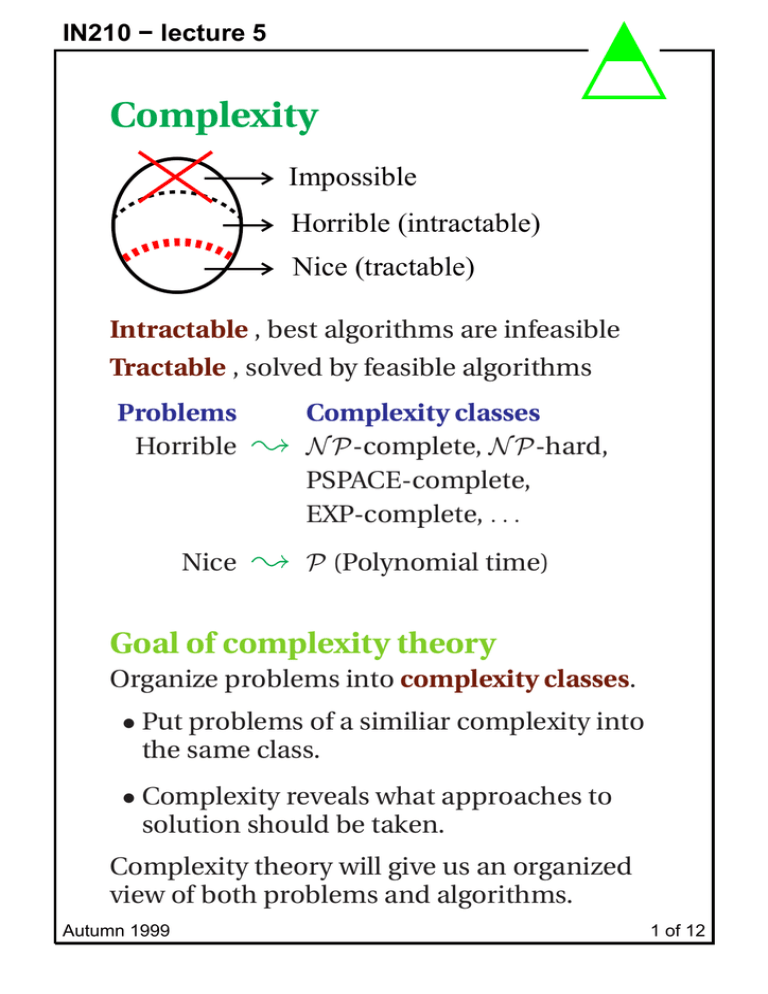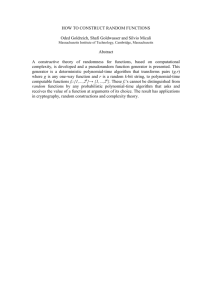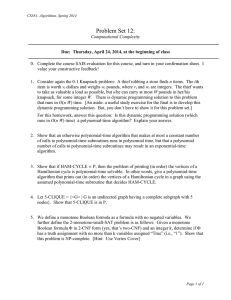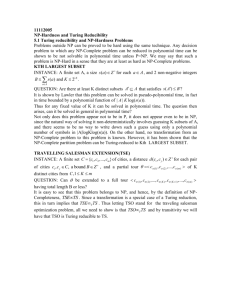Complexity Impossible Horrible (intractable) Nice (tractable)
advertisement

IN210 − lecture 5 Complexity Impossible Horrible (intractable) Nice (tractable) Intractable , best algorithms are infeasible Tractable , solved by feasible algorithms Problems Horrible Nice ; ; Complexity classes N P-complete, N P-hard, PSPACE-complete, EXP-complete, . . . P (Polynomial time) Goal of complexity theory Organize problems into complexity classes. • Put problems of a similiar complexity into the same class. • Complexity reveals what approaches to solution should be taken. Complexity theory will give us an organized view of both problems and algorithms. Autumn 1999 1 of 12 IN210 − lecture 5 Time complexity and the class P We say that Turing machine M recognizes P∗ language L in time t(n) if given any x ∈ as input M halts after at most t(|x|) steps scanning ’Y’ or ’N’ on its tape, scanning ’Y’ if and only if x ∈L. (|x| is the input length – the number of TM tape squares containing the characters of x) Note: We are measuring worst-case behavior of M , i.e. the number of steps used for the most “difficult” input. We say that language L has time complexity t(n) and write L ∈ TIME t(n) if there is a Turing machine M which recognizes L in time O (t(n)). Polynomial time P= S TIME (nk ) k Note: P (as well as every other complexity class) is a class (a set) of formal languages. Autumn 1999 2 of 12 IN210 − lecture 5 “Nice” or “tractable” Real time on a PC/Mac/Cray/ Hypercube/ . . . ; ; P Turing machine time (number of steps) Computation Complexity Thesis All reasonable computer models are polynomial-time equivalent (i.e. they can simulate each other in polynomial time). Consequence: P is robust (i.e. machine independent). Real-world Worst-case complexity difficulty Feasible solution ; ; ; Polynomial-time algorithm O (t(n)) • t(n) Argument: “for large-enough n . . . ” • n100 ≤ nlog n. Yes, but only for n > 2100. Argument: Functions like n100 or nlog n don’t tend to arrise in practice. n 2 already for small or medium-sized inputs: 2 Autumn 1999 n 2 n n2 3 of 12 IN210 − lecture 5 Polynomial-time simulations & reductions We say that Turing machine M computes function f (x) in time t(n) if, when given x as input, M halts after t(|x|) = t(n) steps with f (x) as output on its tape. Function f (x) is computable in time t(n) if there is a TM that computes f (x) in time O (t(n)). For constructing the complexity theory we need a suitable notion of an efficient ’reduction’: ML MR 2 M L1 We say that L1 is polynomial-time reducible to L2 and write L1 ∝ L2 if there is a polynomial-time computable reduction from L1 to L2. Autumn 1999 4 of 12 IN210 − lecture 5 For arguments of the type L1 is hard/complex ⇒ L2 is hard/complex we need the following lemma: Lemma 1 A composition of polynomial-time computable functions is polynomial-time computable. Proof: x Mf f1(x) 1 t1 Mf f2 (f1(x)) 2 t2 t • |f1(x)| ≤ t1(|x|) because a Turing machine can only write one symbol in each step. • “polynomial polynomial = polynomial” or k l n = nk∗l • t2 |f1(x)| is a polynomial. • TIME (t) = t1(|x|) + t2 |f1(x)| is a polynomial because the sum of two polynomials is a polynomial. Autumn 1999 5 of 12 IN210 − lecture 5 (computationally) hard We want to make a cut! easy all solvable problems Strategy It is the same as before (in uncomputability): • Prove that a problem L is easy by showing an efficient (polynomial-time) algorithm for L. • Prove that a problem L is hard by showing an efficient (polynomial-time) reduction (L1 ∝ L) from a known hard problem L1 to L. Difficulty Finding the first truly/provably “hard” problem. Way out Completeness & Hardness Autumn 1999 6 of 12 IN210 − lecture 5 N P-completeness How to prove that a problem is hard? Completeness We say that language L is hard for class C with respect to polynomial-time reductions†, or C-hard, if every language in C is polynomial-time reducible to L. We say that language L is complete for class C with respect to polynomial-time reductions†, or C-complete, if L ∈C and L is C-hard. † Other kinds of reductions may be used Note: • If L is C-complete/C-hard and L is easy (L ∈ P) then every language in C is easy. • L is C-complete means that L is “hardest in” C or that L “characterizes” C. Autumn 1999 7 of 12 IN210 − lecture 5 N P (non-deterministic polynomial time) A non-deterministic Turing machine (NTM) is defined as deterministic TM with the following modifications: • NTM has a transition relation 4 instead of transition function δ n o 4 : (s, 0), (q1, b, R) , (s, 0), (q2, 1, L) , . . . • NTM says ‘Yes’ (accepts) by halting Note: A NTM has many possible computations for a given input. That is why it is non-deterministic. initial config. t (n) accept time • Mathematician doing a proof • The original TM was a NTM Autumn 1999 ; NTM 8 of 12 IN210 − lecture 5 We say that a non-deterministic Turing machine M accepts language L if there exists halting computations of M on input x if and only if x ∈ L. Note: This implies that NTM M never stops if x∈ / L (all paths in the tree of computations have infinite lengths). We say that a NTM M accepts language L in (non-deterministic) time t(n) if M accepts L and for every x ∈ L there is at least one accepting computation of M on x that has t(|x|) or fewer steps. We say that L ∈ NTIME t(n) if L is accepted by some non-deterministic Turing machine M in time O (t(n)). NP = S NTIME (nk ) k Note: All problems in N P are decision problems since a NTM can answer only ’Yes’ (there exists a halting computation) or ’No’ (all computations “runs” forever). Autumn 1999 9 of 12 IN210 − lecture 5 The meaning of “L is N P-complete” Complexity Many people have tried to solve N P-complete problems efficiently without succeeding, so most people believe N P6=P, but nobody has proven yet that N PCproblems need exponential time to be solved. L is computationally hard (L ∈ N P): L ∈ P ⇒ NP = P Physiognomy Checking if x ∈ L is easy, given a certificate. Autumn 1999 10 of 12 IN210 − lecture 5 Example: H AMILTONICITY v1 v2 v5 v3 v4 • A deterministic algorithm “must” do exhaustive search: v1 → v4 → v3 → v2 → backtrack &v → 2 n! possibilities (exponentially many!) • A non-deterministic algorithm can guess the solution/certificate and verify it in polynomial time. v2 v3 1 2 v41 time 1 v5 1 v1 1 v1 2 3 v4 v5 v3 v2 v1 v2 bactracking to v1 Certificate: (1,1,1,1,1) Note: A certificate is like a ticket or an ID. Autumn 1999 11 of 12 IN210 − lecture 5 Proving N P-completeness 1. L ∈ N P Prove that L has a “short certificate of membership”. Ex.: H AMILTONICITY certificate = Hamiltonian path itself. 2. L ∈ N P-hard Show that a known N P-complete language (problem) is polynomial-time reducible to L, the language we want to show N P-hard. L First NP-complete language Cook’s Theorem (Cook, Levin 1971/73) S ATISFIABILITY is N P-complete. Autumn 1999 12 of 12






